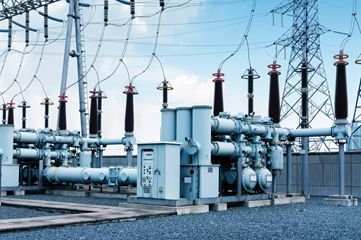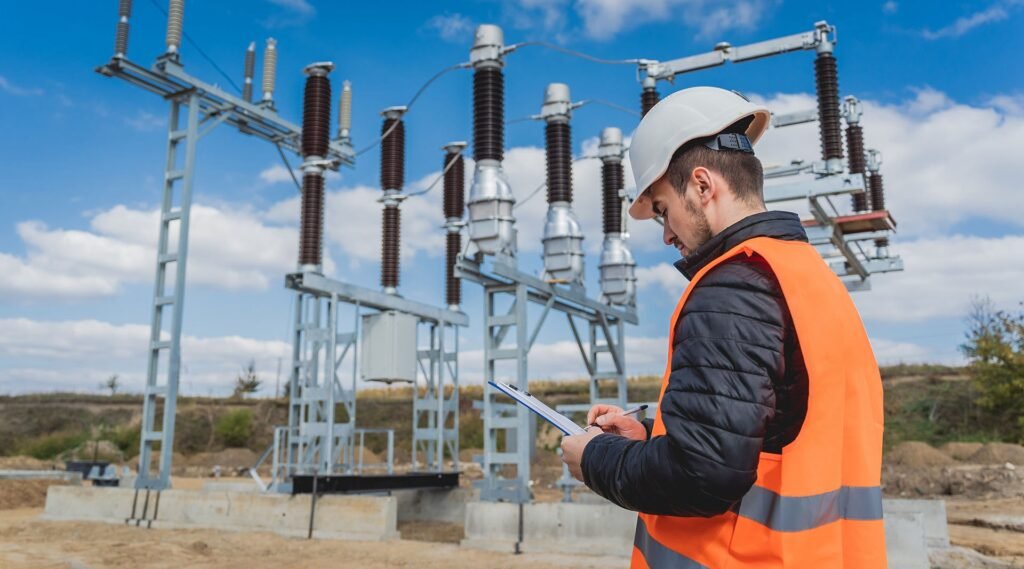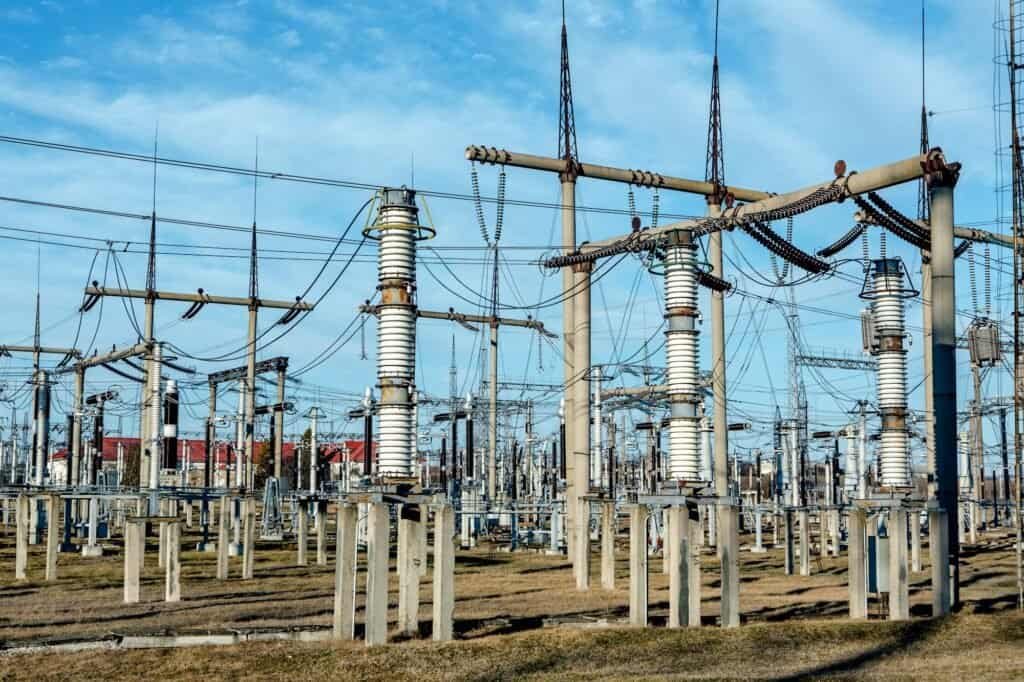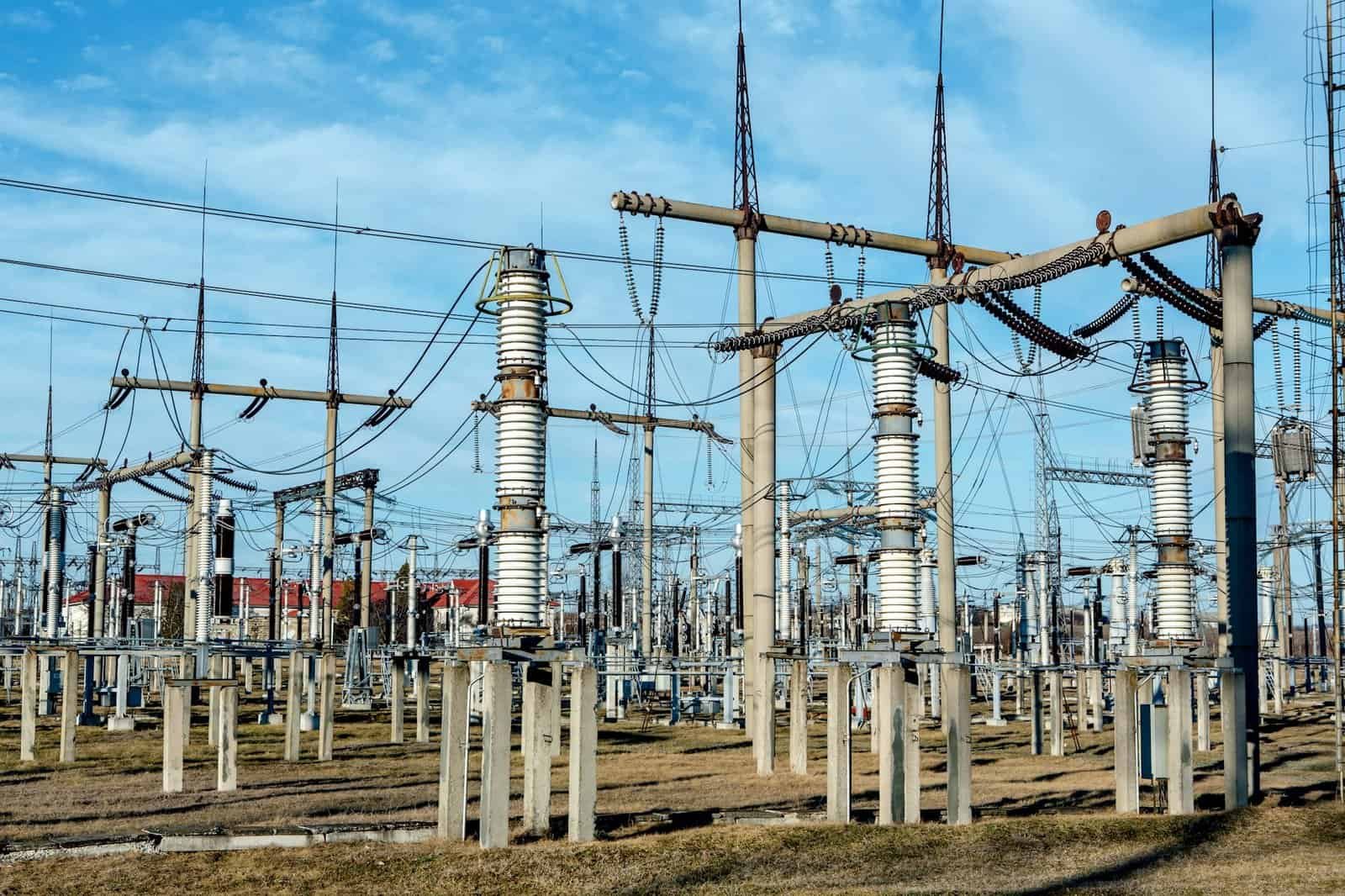A high-voltage circuit breaker is an essential type of electrical switching equipment used in high-voltage power systems. Its primary function is to control the switching operations under normal conditions and to automatically disconnect the circuit under abnormal conditions, such as in cases of short-circuit or overload, to protect the power system and equipment from damage. High-voltage circuit breakers are commonly installed in substations, distribution rooms, or along power lines to control and ensure the stable operation of power systems.
The key features of high-voltage circuit breakers include:
- High Voltage Capacity: Suitable for high-voltage grids, such as 11kV, 35kV, 110kV, and other voltage levels.
- Current Interruption Ability: Capable of breaking large short-circuit currents during faults to protect system integrity.
- Isolation Function: Allows safe isolation of the power supply during maintenance or repair to ensure worker safety.
- Control and Protection: In addition to basic switching functions, high-voltage circuit breakers offer control and protection features, such as overload and short-circuit protection.
- Operating Mechanism: Can be operated manually or controlled remotely, using electric or pneumatic mechanisms.
- Arc Extinguishing Capability:Equipped with a specialized arc-extinguishing chamber to effectively extinguish arcs that could otherwise lead to equipment damage or safety hazards.
- Sealing: For circuit breakers using SF6 (sulfur hexafluoride) gas, effective sealing is critical to maintain the stability of the gas and prevent leakage.
Types of High-Voltage Circuit Breakers
High-voltage circuit breakers are the most essential control devices in power systems, with a wide range of types and specialized functions. Based on different arc-extinguishing media, high-voltage circuit breakers can be categorized as follows:
1) Oil Circuit Breakers
Bulk-Oil Circuit Breakers: These breakers enclose the contact system within a tank filled with transformer oil, which serves both as an arc-extinguishing medium and as insulation between conductive components and the grounded tank. While they offer strong support and withstand various atmospheric conditions, they are large, require significant amounts of oil, and pose a higher risk of explosion and fire. Additionally, they have high maintenance demands and are now less commonly used.
Minimum-Oil Circuit Breakers: In these breakers, the arc-extinguishing chamber is housed in an insulated or ungrounded metal cylinder, using only minimal transformer oil for arc extinguishing and contact gap insulation. Their simple structure, low material usage, compact size, lightweight design, stable performance, and ease of operation make them cost-effective and widely used.
2) Sulfur Hexafluoride Circuit Breakers (SF6 Circuit Breakers)
Utilizing SF6 gas as both an insulating and arc-extinguishing medium, these breakers offer excellent electrical insulation and arc-extinguishing capabilities. They support a high number of operations, have extended maintenance intervals, strong breaking performance, and a compact footprint. However, they require high manufacturing precision, effective sealing, and rigorous moisture and gas control. SF6 circuit breakers are commonly used in medium-voltage power supply lines, especially in regions like Guangdong.
3) Vacuum Circuit Breakers
Vacuum circuit breakers use the high dielectric strength of a vacuum to extinguish arcs, offering fast arc-extinguishing, long service life, lightweight design, and compact size. They are suitable for environments with corrosive or flammable conditions and for high or low-temperature applications. These breakers have low maintenance needs, although they are relatively expensive and prone to overvoltage, making them popular for distribution networks.
4) Air Circuit Breakers
Also known as compressed air circuit breakers, they use pre-stored compressed air for both arc extinguishing and as a driving force. With high arc-extinguishing capacity, large current-breaking ability, and fast action, they are effective yet complex in structure, require considerable materials, and need additional equipment like compressed air systems. These breakers are generally used only in large-capacity power systems rated at 110kV and above.
5) Solid Gas Circuit Breakers
In these breakers, the high-temperature arc decomposes solid gas-producing materials, which generate gas to act as the arc-extinguishing medium.
6) Magnetic Blow Circuit Breakers
These breakers use the electromagnetic force generated by the large current passing through them to quickly stretch and draw the arc into a magnetic arc-extinguishing chamber for cooling. Magnetic blow circuit breakers are safe to operate and easy to maintain, though they are complex, large, and costly, making them generally suitable only for voltage levels below 20kV.
Each type of high-voltage circuit breaker has distinct advantages, serving specific roles based on their arc-extinguishing media and application needs.

Common Failures in High-Voltage Circuit Breakers
High-voltage circuit breakers play a crucial role in controlling and protecting power systems, and their operational condition directly impacts the reliability and stability of power supply. However, due to factors such as design, manufacturing quality, operating conditions, maintenance practices, electrical power loads, and high current impact, high-voltage circuit breakers may experience various faults over time. Below are some common high-voltage circuit breaker failures and their causes:
- Insulation Failures: This is one of the most common issues, including internal insulation failure, external insulation failure, and porcelain jacket flashover. Internal insulation failures may arise from foreign objects or flaking material inside the breaker. External insulation or porcelain sleeve flashovers can be due to improper sizing of the porcelain sleeve, inadequate leakage distance of the outer insulation, or defects in the porcelain sleeve quality.
- Current-Carrying Faults: These faults are typically related to lead overheating or poor contact. Poor contact may occur due to misalignment of static contacts or collision with the arc extinguishing nozzle during operation.
- Failure to Operate: This type of failure can be due to either mechanical or electrical issues. Mechanically, it may be caused by a fault in the drive system of the operating mechanism, such as damaged, displaced, or deformed parts. Electrically, the cause may lie in auxiliary circuit or control circuit malfunctions.
- Operating Cycle Issues: High-voltage circuit breakers are designed to withstand a certain number of closing, opening, or re-closing operations. If issues arise with the operating cycle, it may impair the breaker’s normal functionality.
- Seal Failure: Seal failure can lead to gas leakage or allow external contaminants to enter the circuit breaker, compromising its performance and safety.
- Overvoltage Faults: High-voltage circuit breakers may experience insulation breakdown or even fire due to overvoltage shocks, leading to significant failures.
- Overload Faults: Prolonged overload conditions can result in contact burnout or fuse failure, affecting the circuit breaker’s normal operation.
- Frequent Tripping: Factors such as an undersized current transformer ratio, excessive inrush current, or grounding or short circuits in the line may lead to frequent tripping of circuit breakers.
To ensure the reliable operation of high-voltage circuit breakers, regular preventive testing and maintenance are essential to detect and address these potential failures early. Fault diagnosis technology can help quickly identify the location, severity, and cause of equipment failures, providing valuable data to support condition-based maintenance decisions.
Why test high voltage circuit breakers?
Some importance reasons for testing high-voltage circuit breakers are ensure they:
- Ensuring Safe Operation: High-voltage circuit breakers are critical switching devices in power systems, and their performance is directly linked to the safe and stable operation of the power grid. Testing ensures that circuit breakers can accurately and swiftly open or close circuits as needed, safeguarding the power system’s reliable operation.
- Preventing Operational Accidents: Since circuit breakers play a vital role in power systems, failures can lead to significant economic losses or even casualties. Regular testing of their mechanical characteristics can help prevent such incidents by identifying potential faults early.
- Assessing Quality and Performance: Testing the operating voltage range, opening and closing speeds, timing, and synchronization of high-voltage circuit breakers provides key mechanical performance data. These parameters allow for an accurate assessment of the breaker’s quality and operational reliability.
- Guiding Maintenance and Upkeep: Circuit breakers require regular inspection and maintenance to ensure proper functioning. By analyzing mechanical characteristics through testing, potential issues can be identified and addressed promptly. Testing also gives operators deeper insights into the working principles and mechanical features of circuit breakers, enabling more effective maintenance and repair.
- Enhancing System Efficiency: Thorough testing of the mechanical characteristics of high-voltage circuit breakers reduces the risk of power outages caused by breaker failures, thereby increasing the overall efficiency and reliability of the power system.
Testing high-voltage circuit breakers is a proactive measure that strengthens power system reliability, supports safety, and enhances operational efficiency.
Preventive Testings for High-Voltage Circuit Breakers

To maintain reliable, safe operation of high-voltage circuit breakers, regular preventive testing is crucial. These tests ensure the breaker’s integrity and functionality, preventing potential faults that could lead to system failures or unsafe conditions. Key test items include:
1) Insulation Resistance Test
The insulation resistance test serves as a fundamental assessment of a circuit breaker’s insulation performance. By measuring the resistance, this test evaluates the ability of the circuit breaker’s internal insulation materials to block unwanted current flow. A high resistance value indicates strong insulation, which is essential for maintaining operational reliability and avoiding electrical faults. Regular insulation resistance testing helps identify early signs of insulation degradation, allowing for timely maintenance and ensuring the circuit breaker performs correctly to safeguard the power system.
2) Dielectric Loss Factor (tgδ) Test
This test is critical for non-pure ceramic bushings and multi-oil circuit breakers rated at 40.5 kV and above. The dielectric loss factor (tgδ) test measures energy loss within the insulation when an AC voltage is applied. High dielectric losses can indicate poor insulation quality or moisture ingress. Monitoring the tgδ values allows operators to gauge the condition of the insulation materials, ensuring that these components function safely under high-voltage stress. This test is particularly valuable in monitoring the insulation’s aging process and planning maintenance schedules.
3) Conductive Circuit Resistance Measurement
Often referred to as contact resistance measurement, this test uses a double-arm bridge to evaluate the quality of contacts within the circuit breaker. Proper contact resistance values ensure effective current flow without excessive heating, which could lead to malfunctions or damage over time. High contact resistance can indicate corrosion, poor alignment, or other issues affecting the circuit breaker’s conductive parts. By keeping this resistance within acceptable limits, this test helps maintain circuit integrity and prevents overheating, especially critical in high-voltage applications.
4) AC Voltage Withstand Test
This test assesses the insulation strength of the circuit breaker under high AC voltage conditions. Conducted separately in both open and closed states, the AC voltage withstand test applies a high AC voltage to the circuit breaker, monitoring for any signs of flashover or breakdown. If the breaker withstands the voltage without failure, it is considered to have passed, confirming its insulation strength. This direct and effective method is fundamental in determining the breaker’s capacity to withstand high-voltage conditions safely.

5) Vacuum Degree Test for Vacuum Circuit Breakers
Vacuum circuit breakers rely on a vacuum to interrupt electrical currents without generating arcs. Regular testing of the vacuum level ensures that it remains within the necessary range for effective operation. A low vacuum level can reduce the breaker’s arc-extinguishing ability, leading to equipment failure or accidents. Quantitative measurements of vacuum levels allow for predicting the equipment’s lifespan and scheduling replacements or repairs, contributing to the safe and prolonged operation of vacuum circuit breakers.
6) Circuit Break Mechanical Characteristic Test
Evaluating the mechanical characteristics of the circuit breaker, such as opening and closing time, speed, and synchronization, is essential for assessing its action characteristics. This test examines how mechanical structure, friction, and stored mechanical energy impact performance. Proper timing and synchronization are critical to prevent malfunctions that could result in system faults or operator hazards. Ensuring accurate, reliable mechanical action helps maintain breaker performance and system reliability, particularly in environments where high-speed fault isolation is necessary.
7) Primary Injection Current Test:
High-voltage circuit breakers are subjected to large currents during operation. Using a primary injection current tester simulates the real operational current environment. By regularly performing high current tests, the circuit breaker’s breaking and closing performance can be verified, and potential failures or accidents can be detected early, enhancing the reliability and safety of the power system.
8) SF6 Gas Leakage and Water Content Test
SF6 gas, used in SF6 circuit breakers, is a critical insulation and arc-extinguishing medium. This gas must maintain high purity and low moisture content to function effectively. The SF6 gas leakage and micro-water test assess the purity and dryness of the SF6 gas, verifying that it remains suitable for insulation and arc extinguishing. Maintaining proper gas levels and moisture content helps ensure that SF6 circuit breakers operate safely and reliably, reducing risks associated with gas degradation or leakage.
9) Insulating Oil Tests (for Oil Circuit Breakers)
For oil circuit breakers, insulating oil quality is key to maintaining insulation and cooling functions. Tests for parameters like water-soluble acid (pH), acid value, closed flash point, moisture, interfacial tension, dielectric loss factor (tanδ), insulation breakdown voltage, volume resistivity, and gas content in oil provide comprehensive insights into the oil’s condition. Additionally, analyzing dissolved gas components using chromatography can detect incipient faults. Regular oil testing helps identify issues early, ensuring the insulation and arc-quenching performance of oil circuit breakers remain within safe limits.
By regularly conducting these preventive tests, potential issues in high-voltage circuit breakers can be identified and addressed early, ensuring their safe and reliable operation.






